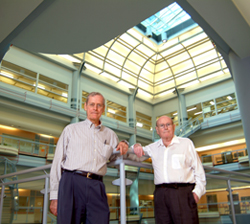
Toronto (Jan. 31, 2011) - Fifty years ago today, two young, unknown scientists at the fledgling Ontario Cancer Institute (OCI) published accidental findings that proved the existence of stem cells – cells that can self-renew repeatedly for different uses.
Today, acclaimed the world over as the "fathers of stem cell science", Drs. James Till, a biophysicist, and Ernest McCulloch, a haematologist, and both also Professors Emeriti at the University of Toronto, are being honoured by the next generation of scientific peers, colleagues and students on the anniversary of their pivotal discovery. The occasion will also honour the memory of Dr. McCulloch who died Jan. 20.
"It's impossible to overstate the enormity of Till's and McCulloch's discovery and long-time collaboration. Their work changed the course of cancer research and lit the way to what we now call regenerative medicine – the use of stem cells for bone marrow transplants and many other types of disease research," says Dr. Christopher Paige, Vice-President, Research at University Health Network, which includes OCI, the research arm of Princess Margaret Hospital.
Over the years, international excitement generated by the stem cell discovery has inspired and attracted many talented scientists to Toronto the study with Till and McCulloch at OCI and the University.
"Toronto is truly the city where stem cell science was born, thanks to Till and McCulloch," says Dr. Paige.
"The promise of stem cell research for healing and helping humanity is the great living legacy of Professors Till and McCulloch. The outstanding community of innovative stem cell researchers here in Toronto is testimony to the enduring impact of their work," said Catharine Whiteside, Dean, Faculty of Medicine at University of Toronto.
The bright promise of their initial discovery shines constantly among the next generation who are also devoting their life's work to advancing stem cell science. Two examples: Dr. John Dick, who pioneered the field of
cancer stem cells when he discovered them first in human leukemia and next in colon cancer; and Dr. Gordon Keller, a stem cell scientist lured home to Canada from New York City to lead Toronto's McEwen Centre for Regenerative Medicine, which focuses on harnessing the power of stem cells to advance treatment of a wide range of debilitating diseases including heart, lung and diabetes, and spinal cord and neurodegenerative disorders. Drs. Dick and Keller, both senior scientists at OCI and the McEwen Centre, are Professors at U of T who also hold Canada Research Chairs to further understand stem cell biology.
And the story behind the discovery Dr. Till always describes as "accidental"? It is really a testament to the elegance of basic scientific research – using keen powers of observation, and diligently and systematically testing each hypothesis, says Dr. Paige.
When Till and McCulloch began collaborating in the late 1950s, they were studying radiation sensitivity by injecting bone marrow cells into irradiated mice. They observed visible nodules in the spleens of the mice in proportion to the number of bone marrow cells injected. They named the nodules spleen colonies, and speculated that each nodule arose from a single marrow cell – perhaps a stem cell.
This discovery, for which Till and McCulloch won the coveted Gairdner Foundation International Award in 1969, laid the foundation for bone marrow transplantation. The scientists, both appointed Officers of the Order of Canada, were inducted into the Canadian Medical Hall of Fame in 2004. The next year they received the Albert Lasker Award for Basic Medical Research – considered the most prestigious medical science award in the United States. In 2007, they received the National Cancer Institute of Canada Diamond Jubilee Award.
From the outset, Till and McCulloch set down the rules of their partnership and agreed to alternate authorship of published results. Dr. McCulloch described the agreement as "a plan that insured them against arguments about priority that could well sour their cordial relationship".
For more than 50 years after beginning their fruitful collaboration, the bond remained strong between the revered, world-renowned scientists who first put Toronto on the map as the birthplace of stem cell science.
The landmark paper, first published in
Radiation Research, established a quantitative method for the study of individual stem cells. To mark the 50th anniversary, the journal has republished the original paper at
http://www.rrjournal.org/doi/abs/10.1667/RRXX28.1
About the University of Toronto
Established in 1827, the University of Toronto has assembled one of the strongest research and teaching faculties in North America, presenting top students at all levels with an intellectual environment unmatched in breadth and depth on any other Canadian campus. U of T faculty co-author more research articles than their colleagues at any university in the US or Canada other than Harvard. As a measure of impact, U of T consistently ranks alongside the top five U.S. universities whose discoveries are most often cited by other researchers around the world. The U of T faculty are also widely recognized for their teaching strengths and commitment to graduate supervision.
About Princess Margaret Hospital
Princess Margaret Hospital and its research arm, the Ontario Cancer Institute, which now includes The Campbell Family Cancer Research Institute and The Campbell Family Breast Cancer Research Institute, have achieved an international reputation as one of the top 5 cancer research centres in the world. Princess Margaret Hospital is a member of University Health Network, which also includes Toronto General Hospital and Toronto Western Hospital. All three are research hospitals affiliated with the University of Toronto.
